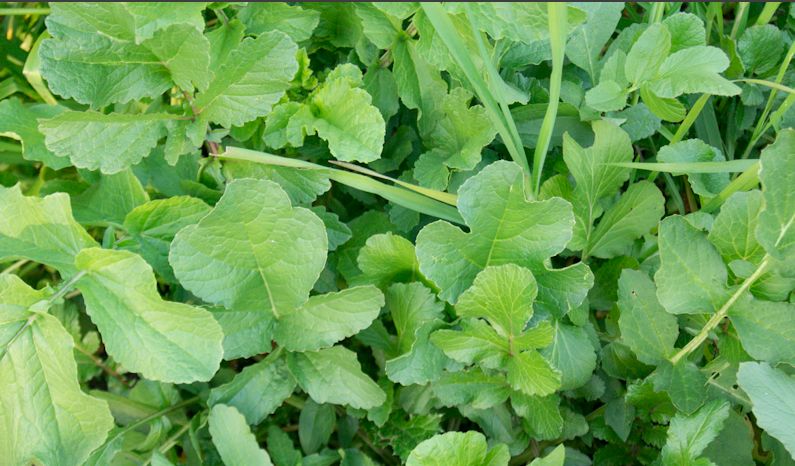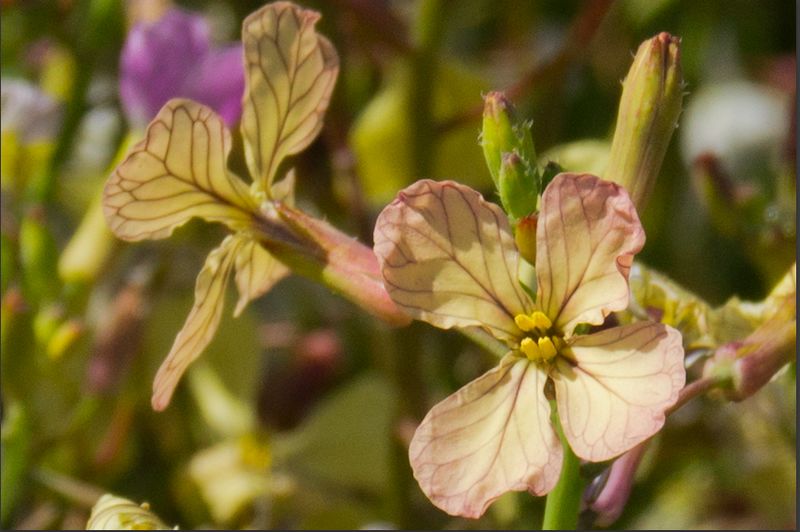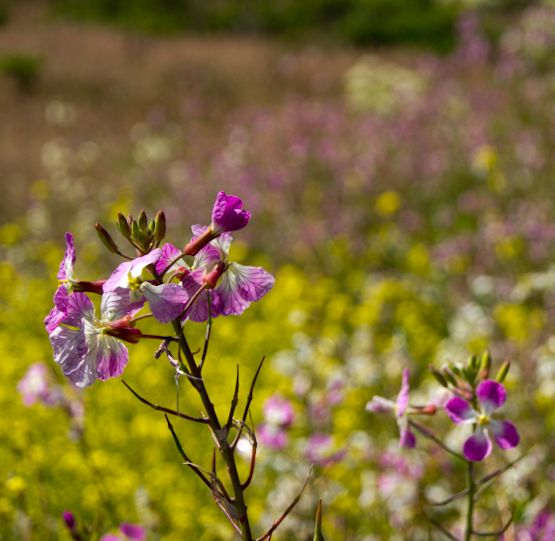




Petal color in R. sativus is determined by two independently assorting loci, producing four petal colors (yellow, white, pink, and bronze). We studied a large naturalized population of Raphanus sativus in open coastal prairie at the University of Cali- fornia, Davis, Bodega Marine Reserve (BMR), a 147-ha biological reserve located on the Pacific Coast in Bodega Bay, California (3819N, 12304W). Populations of many thousands of individuals of R. sativus are located in several areas at the reserve. At the BMR, R. sativus is an annual self-incompatible herb that germinates in October, with peak blooming for ∼3–4 months from mid-March to mid- June. The flowers of R. sativus are polymorphic with re- spect to petal color. Petal color is determined by two in- dependently assorting loci controlling the expression of carotenoids and anthocyanins (Panetsos 1964). Plants may express flowers with yellow petals (recessive at both loci), pink petals (dominant at both loci), white petals (domi- nant at the carotenoid locus), or bronze petals (dominant at the anthocyanin locus; table 1).
Wild radish The petals may vary in colour; yellow or white petals are more common than purple, pink or brown. Petals often have light or dark distinct veins.The seed pod is constricted between the seeds and does not split lengthwise. It breaks up into distinct segments when ripe and during threshing it is often broken up into single-seeded segments. Each pod usually has 3–9 seeds, ovoid to almost globular, yellowish to reddish brown, and covered with white bran-like scales. There is no seed in the beak of the pod. ... Garden radish is similar to wild radish in the above-ground parts but the flowers are purplish, pink or white, never yellow. Garden radish seed pods are spongy, lack distinct joints and split in various ways at maturity (not into segments containing single seeds).
Analyses of populations of
Raphanus growing in the central part of California, from the Sierra Nevada foothills to the Pacific coast, show that pure
R. raphanistrum can be found only in the Central Valley, while over the remainder of the area populations of the so-called

wild

(weedy)
R. sativus occur. More detailed morphological studies of a number of populations in this area have revealed that the populations of

wild
 R. sativus
R. sativus originated by hybridization of the cultivated forms of this species (the radish) with another introduced species, already a weed,
R. raphanistrum. The composition of each hybrid population with respect to the proportion of characters of the one or the other species depends upon the habitat it occupies and its geographic location. Populations in inland areas display a high proportion of
R. raphanistrum characters, while in those near the coast
R. sativus characters predominate. --
The origin of variation in “wild"Raphanus sativus (Cruciferae) in California C. A. Panetsos and H. G. Baker Genetica Volume 38, Number 1 (1967), 243-274
, DOI: 10.1007/BF01507462
California wild radish (most commonly referred to in the scientific literature as
Raphanus sativus) is an exotic weed of naturally disturbed coastal areas from southern Oregon to Baja California and human-disturbed inland California valleys (
Panetsos and Baker, 1967;
DiTomaso and Healy, 2006;
Hegde et al., 2006). Wild radish in this region is best described as a “coalescent complex," the result of a unique history of hybridization between cultivated radish, also given the Latin binomial
R. sativus, and the related weed
R. raphanistrum L., known commonly as jointed charlock. In the mid-1800s, both cultivated radish and
R. raphanistrum were introduced to the San Francisco Bay area from Europe; cultivated radish was introduced as a crop, whereas
R. raphanistrum arrived accidentally, probably as a weed contaminant of grain (
Robbins, 1940). By the early 1900s, hybrids of radish and jointed charlock, recognized by their mixture of traits from both cultivated radish and
R. raphanistrum, were identified in southern California (
Frost, 1923). In the 1960s, the morphology, cytogenetics, and sexual compatibility of hybridizing
Raphanus populations were studied extensively over an area of northern California, stretching from Monterey Bay to the foothills of the Sierra Nevada Mountains (
Panetsos and Baker, 1967). Today, based on genetic evidence, all populations of California wild radish that have been surveyed appear to be of hybrid origin, with genes and traits of both progenitor parents present and in varying proportions from location to location (
Hegde et al., 2006). ---
http://www.amjbot.org/content/95/11/1437.full
|
|
|
| Raphanus raphanistrum L. |
|
|
| Painted Charlock, jointed charlock, wild radish |
|
|
Raphanus raphanistrum, a dicot, is an annual or perennial herb that is not native to California; it was introduced from elsewhere and naturalized in the wild.
|
|
| Communities: |
weed, species characteristic of disturbed places |
| Habitat: |
disturbed [Walker] |
| Wetlands: |
Occurs in wetlands in another region, but occurs almost always under natural conditions in non wetlands in California [U.S. Fish & Wildlife Service.] |
| Elevation: |
between 0 and 2625 feet |
|
| Family: |
Brassicaceae (TJM2 Treatment) |
| Related: |
See a list of other species in the genus Raphanus found in California. |
|
|
|

Bloom Period |
| Raphanus sativus L. |
|
|
| cultivated radish, jointed charlock, wild radish |
|
Raphanus sativus, a dicot, is an annual or biennial herb that is not native to California; it was introduced from elsewhere and naturalized in the wild.
 The California Invasive Plant Council (Cal-IPC) lists plants that cause serious problems in native ecosystems. Cal-IPC classifies the statewide impact of Raphanus sativus as limited (plant profile). The California Invasive Plant Council (Cal-IPC) lists plants that cause serious problems in native ecosystems. Cal-IPC classifies the statewide impact of Raphanus sativus as limited (plant profile).
|
|
| Communities: |
weed, species characteristic of disturbed places |
| Habitat: |
disturbed [Walker] |
| Wetlands: |
Occurs in wetlands in another region, but occurs almost always under natural conditions in non wetlands in California [U.S. Fish & Wildlife Service.] |
| Elevation: |
between 0 and 3281 feet |
|
| Family: |
Brassicaceae (TJM2 Treatment) |
| Related: |
See a list of other species in the genus Raphanus found in California. |
|

Bloom Period |
R. raphanistrum L. JOINTED CHARLOCK
NATURALIZED
Sparsely to densely hairy.
Stem: (2)3–8 dm, reflexed-hairy.
Leaf: blade 3–15(22) cm, 1–5 cm wide, oblong, obovate, or oblanceolate, lyre-shaped to pinnately lobed; lateral lobes 1–4 pairs, dentate; distal cauline ± sessile, dentate.
Flower: sepals 7–11 mm; petals 15–25 mm, 4–7 mm wide, claw 8–14 mm.
Fruit: cylindric to narrowly lanceolate; proximal segment 1–1.5 mm; terminal segment (1.5)2–11(14) cm, (2.5)3–8(11) mm wide, woody; pedicel ascending to spreading, 0.7–2.5 cm.
Seed: 2.5–3.5 mm, ovoid to oblong.
2n=18. Disturbed areas, fields; < 1100 m. California Floristic Province, Great Basin Floristic Province;
R. sativus L. RADISH
NATURALIZED
Sparsely hairy to glabrous.
Stem: branched distally, (1)4–13 dm.
Leaf: basal blade 2–60 cm, 1–20 cm wide, oblong, obovate, oblanceolate, or spoon-shaped in outline, lyre-shaped to pinnately divided; lateral lobes 1–12, dentate.
Flower: sepals 5.5–10 mm; petals 15–25 mm, 3–8 mm wide.
Fruit: fusiform or lanceolate, occasionally ovoid; proximal segment 1–3.5 mm; terminal segment (1)3–15(25) cm, (0.5)0.7–1.3(1.5) cm, corky; pedicel spreading to ascending, 0.5–4 cm.
Seed: 2.5–4 mm, spheric to ovoid.
2n=18. Disturbed areas, fields; < 1500 m. California Floristic Province; North America, temperate worldwide; native to Mediterranean Europe. See note under Raphanus raphanistrum. May–Jul {Weed listed by BAEDN and Cal-IPCI}[Online Interchange]
Unabridged note: There are Consortium records that, if verified, would voucher elevations up to 2530 m.









 wild
wild (weedy)R. sativus occur. More detailed morphological studies of a number of populations in this area have revealed that the populations of
(weedy)R. sativus occur. More detailed morphological studies of a number of populations in this area have revealed that the populations of  wild
wild R. sativus originated by hybridization of the cultivated forms of this species (the radish) with another introduced species, already a weed,R. raphanistrum. The composition of each hybrid population with respect to the proportion of characters of the one or the other species depends upon the habitat it occupies and its geographic location. Populations in inland areas display a high proportion ofR. raphanistrum characters, while in those near the coast R. sativus characters predominate. -- The origin of variation in “wild"Raphanus sativus (Cruciferae) in California C. A. Panetsos and H. G. Baker Genetica Volume 38, Number 1 (1967), 243-274, DOI: 10.1007/BF01507462
R. sativus originated by hybridization of the cultivated forms of this species (the radish) with another introduced species, already a weed,R. raphanistrum. The composition of each hybrid population with respect to the proportion of characters of the one or the other species depends upon the habitat it occupies and its geographic location. Populations in inland areas display a high proportion ofR. raphanistrum characters, while in those near the coast R. sativus characters predominate. -- The origin of variation in “wild"Raphanus sativus (Cruciferae) in California C. A. Panetsos and H. G. Baker Genetica Volume 38, Number 1 (1967), 243-274, DOI: 10.1007/BF01507462

 The
The